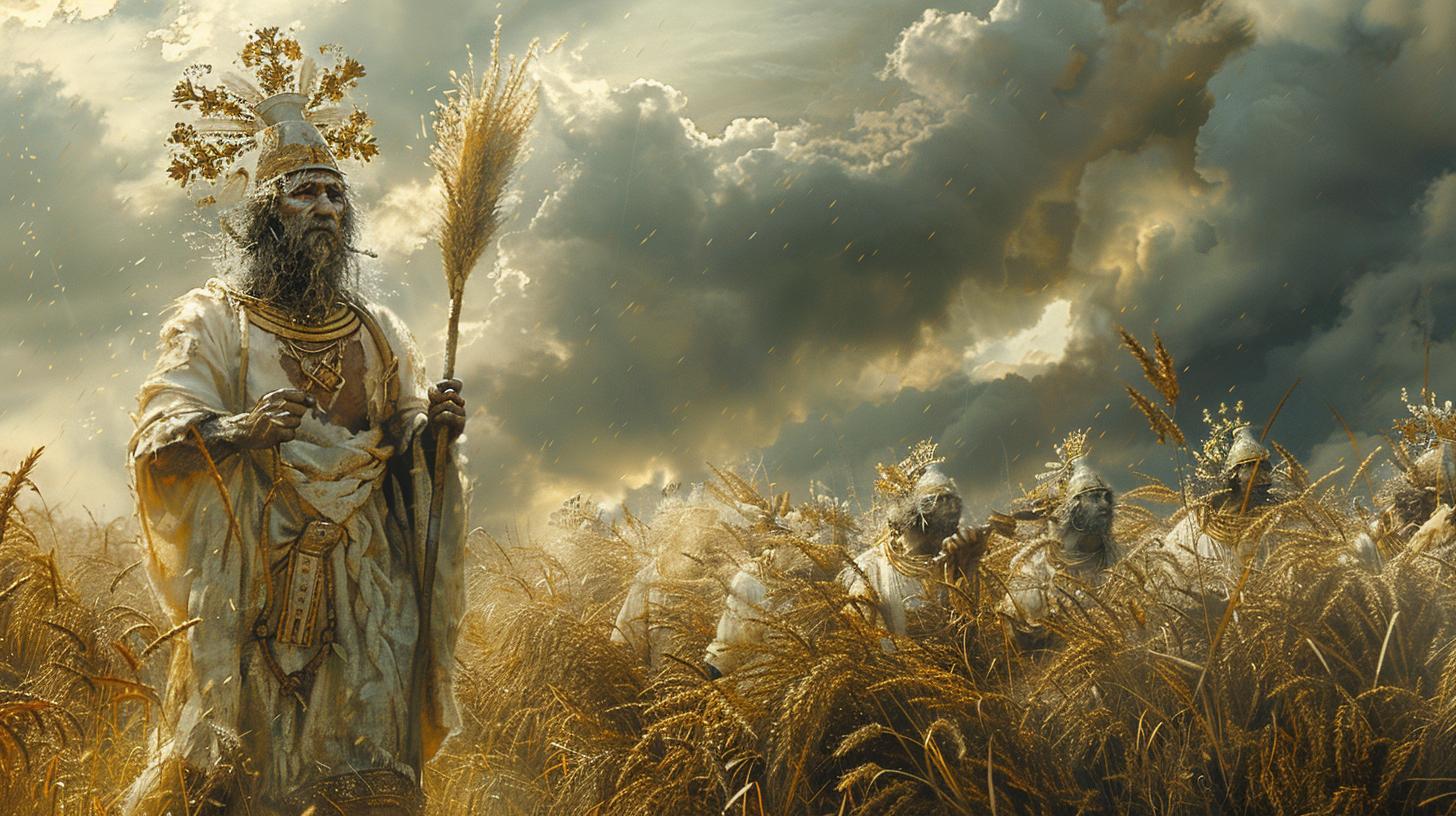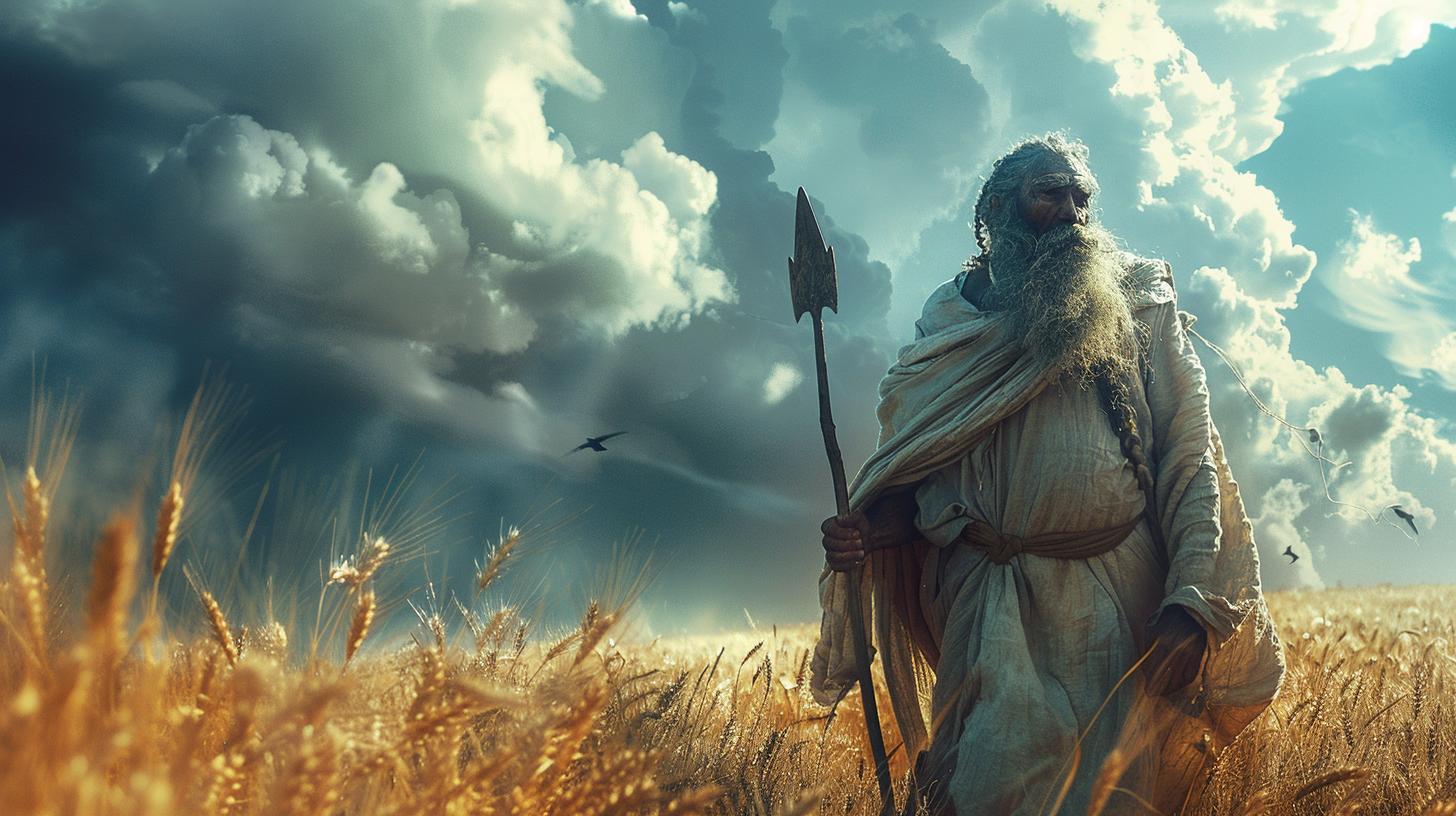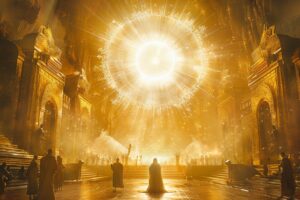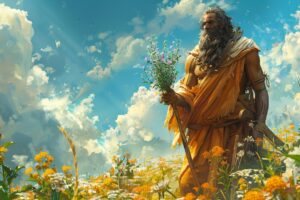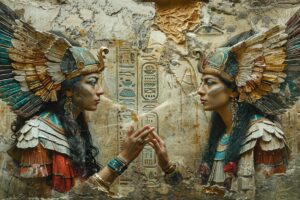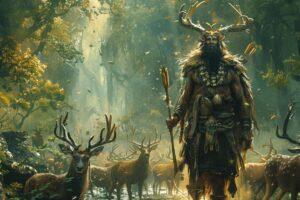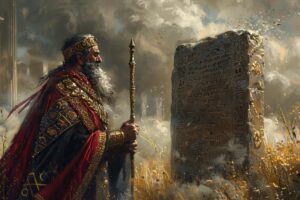Tarhunt God: Origins, Symbols, and Worship
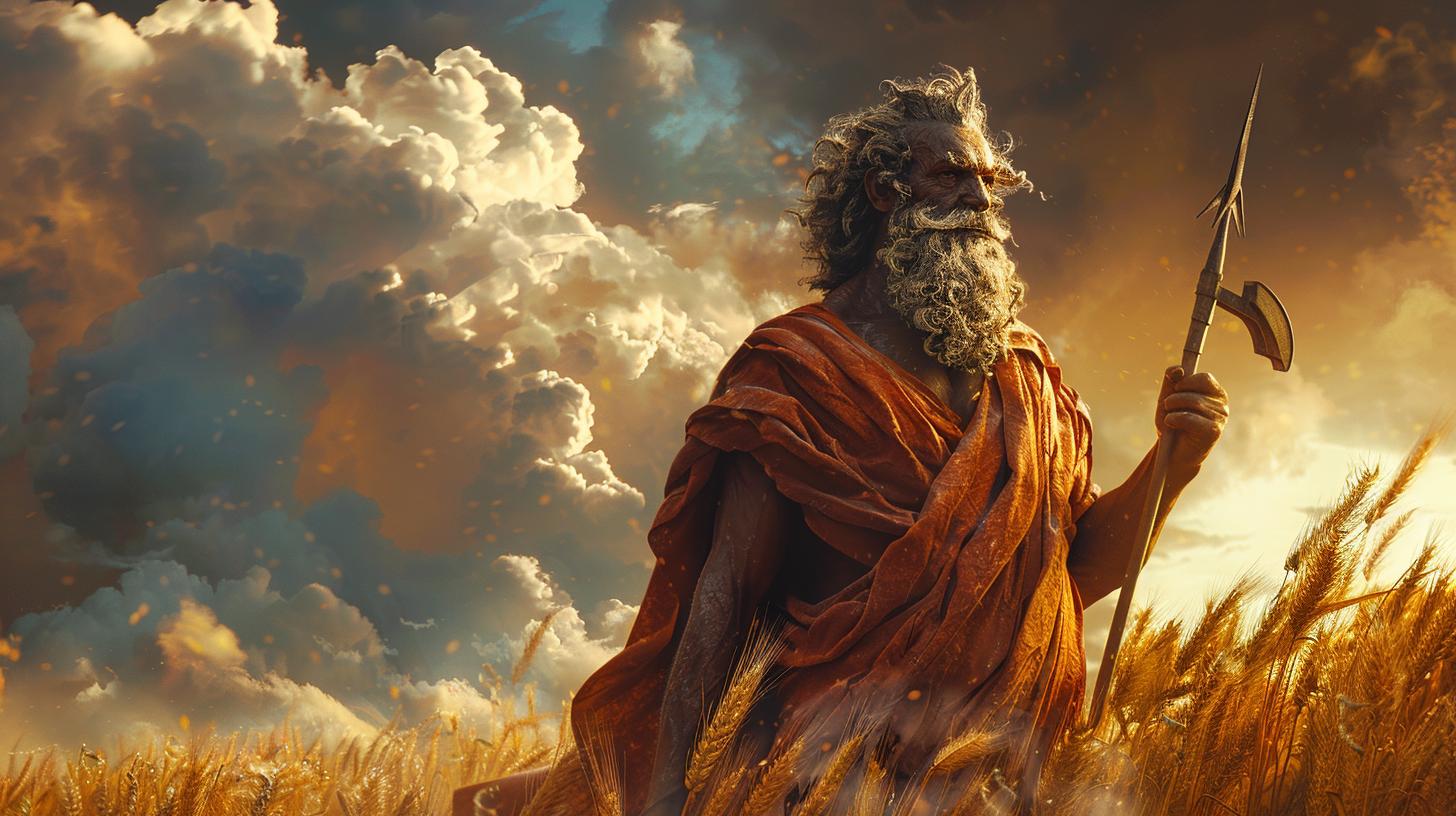
Tarhunt was a major deity in ancient Anatolia, revered during the Bronze and Iron Ages. Associated with weather, he played a significant role in the spirituality and daily life of the Hittites and Luwians.
His name varied across regions, reflecting his Proto-Indo-European roots. Tarhunt was commonly depicted with symbols like the bull and horse, representing his power and significance in mythological and agricultural contexts.
Origins and Names
Tarhunt, a significant figure in Anatolian mythology, has roots deeply embedded in Proto-Indo-European culture with various linguistic connections and name variations over time.
Linguistic Roots
Tarhunt’s name stems from Proto-Anatolian origins. The Proto-Anatolian term *Tṛḫu-ent- translates roughly to ‘conquering,’ tying directly to the word tarḫu-zi in the Hittite language, meaning ‘prevail, conquer, be powerful.’
This etymology roots Tarhunt firmly in the concept of dominance and power, emphasizing his role not just in weather but also as a symbol of strength and victory.
The verb *terh₂ (‘cross, overcome’) contributes to this powerful imagery, highlighting his force as a supreme deity.
Variants of the Name
Tarhunt’s name exhibited various forms across different Anatolian languages. In Hittite, he was known as Tarḫunna; in Luwian, as Tarḫunt; while in Carian and Lycian, his name appeared as Trquδ and Trqqas, respectively.
- The variant Trquδ appears in Carian inscriptions, reflecting the local dialect’s adaptation of the deity’s name.
- Similarly, Trqqas in Lycian texts shows regional linguistic changes, yet holds to the core identity of Tarhunt.
These variations underscore the widespread worship and the adaptability of his name according to local linguistic nuances, symbolizing the broad influence of his mythology across different populations.
Proto-Indo-European Connections
Tarhunt’s functions and attributes have been linked to the Proto-Indo-European god Perkwunos. This association emerges from the adoption of a new epithet, *Tṛḫu-ent- (conqueror), that resonates with the Hattian storm god Taru.
This convergence of names and roles highlights the amalgamation of cultures in Anatolia. Over time, the evolving representation of Tarhunt in different regions and languages indicates a blending of cultural and religious elements.
The merging of the linguistic roots of *terh₂ and the deity Taru reveal the syncretic nature of ancient Anatolian religion, where influences from varied traditions combined to form a unique and powerful mythological figure.
Depiction and Symbols
Tarhunt was depicted in various forms in ancient art, reflective of his power and significance.
Artistic Representations
Artistic representations of Tarhunt reveal much about the god’s importance. His image appeared in various mediums, illustrating his powerful attributes and roles.
Sculptures and Reliefs
Sculptures and reliefs of Tarhunt often portray him as a bearded man with a horned helmet, carrying a lightning bolt or an axe. These items symbolize his association with storms and his dominance.
One of the most significant representations is the İvriz relief, where Tarhunt holds a bunch of grapes and wheat, emphasizing his role in agriculture.
Symbols Associated With Tarhunt
Tarhunt is commonly depicted with symbols signifying fertility and strength. These symbols consistently emphasize his dual nature as a weather deity and a protector.
- The Lightning Bolt: Symbolizes his control over storms and weather.
- The Axe: Represents his warrior aspect and ability to protect and conquer.
- The Horned Helmet: Indicates his divine power and authority.
Animal Representation
Animals often symbolize various attributes of Tarhunt.
The Bull Iconography
The bull is a frequent icon in representations of Tarhunt, symbolizing strength and fertility. This connection to the bull aligns Tarhunt with other ancient storm gods who share similar symbols.
Bulls are often depicted beside him or in a conquered position, underscoring his dominance over nature and life.
The Horse Symbolism
Tarhunt’s connection to the horse is evident in rituals and iconography. Horses represent speed, power, and nobility, characteristics attributed to the deity.
Rituals, such as those described in Uḫḫamuwa’s horse plague ritual in Arzawa, include feeding the god’s horses and anointing their chariot with sheep fat, symbolizing their essential role in Tarhunt’s mythology.
Role and Functions
Tarhunt held significant roles and functions in ancient Anatolia, impacting various aspects of daily life and spirituality.
The Weather God
Tarhunt was revered as a powerful weather god, responsible for controlling the elements. His dominion over the weather was vital for the survival and prosperity of ancient civilizations. He was believed to bring rain, which was essential for crops, and to control storms and thunder, ensuring a balance in nature.
Agricultural Influence
As an agricultural deity, Tarhunt was crucial for ensuring bountiful harvests. Farmers would perform rituals and offer sacrifices to gain his favor for good weather and productive fields. His influence extended to the fertility of the land and the success of agricultural endeavors, which were central to the livelihood of the people.
Military Associations
Protector in Battles
Tarhunt was also seen as a protector in battles. Warriors would seek his blessings before going into combat, believing that his divine intervention would lead them to victory. Representations of him often depict the god in a fierce stance, with weapons ready, symbolizing his readiness to defend and aid his followers in times of war.
King’s Guardian Deity
Kings and rulers worshipped Tarhunt as their guardian deity, believing that he provided divine legitimacy and protection to their reign. This association reinforced the ruler’s power and their connection to the divine.
Tarhunt’s favor was thought to be essential for maintaining stability and order within the kingdom.
Mythological Context
Exploring Tarhunt’s mythological background reveals rich stories and connections with other deities.
Mythological Stories
The Heroic Serpent Battle
One of the most notable mythological tales involving Tarhunt is his battle against a giant serpent. This epic confrontation symbolizes the struggle between order and chaos. Tarhunt, wielding his thunderbolt or axe, ultimately prevails, ensuring the stability of the natural world.
This narrative echoes through various regional myths, emphasizing Tarhunt’s dominant role as a protector.
In some versions, Tarhunt’s victory over the serpent also signifies his control over water bodies, crucial for agriculture and survival.
This myth asserts his ability to overcome adversities, bringing rain and fertility to the land while keeping destructive forces at bay.
Similarities With Other Deities
Tarhunt and Zeus
Tarhunt shares many similarities with Zeus, the famous Greek god. Both deities wield thunderbolts and are associated with the sky and storms. Their primary role as weather gods highlights their immense power over natural elements, influencing agricultural success and societal prosperity.
The battle between Tarhunt and the serpent closely resembles Zeus’s combat with Typhon, a monstrous serpent-dragon. These parallel narratives reinforce the archetypal theme of the heroic god defeating chaos to maintain cosmic order.
Syncretism With Regional Gods
Over time, the figure of Tarhunt merged with various regional gods, reflecting the cultural and religious exchanges in Anatolia. Key syncretic relationships include:
- Taru: The Hattian god closely associated with weather and thunder.
The convergence of Taru and Tarhunt underscores the blending of Hattian and Indo-European traditions.
- Teshub: The Hurrian storm god with significant influence in ancient Near Eastern mythology. Teshub’s association with mountains and weather parallels Tarhunt’s attributes, showing a fusion of religious beliefs.
This syncretism extended into the Roman era, transforming Tarhunt into Jupiter Dolichenus, a god venerated by Roman legions.
These integrations highlight the fluid nature of ancient religious identities and the enduring legacy of Tarhunt across different cultures and periods.
Cult and Worship
Tarhunt’s worship was central to many ancient Anatolian communities, marked by various rituals and dedicated sites.
Major Worship Centers
Worship in Aleppo
Aleppo was a significant center for Tarhunt’s worship, especially following the Hittite conquest. The site was adapted to fit Hittite religious practices and became a focal point for the deity’s veneration.
Tarhunt was known locally as the ‘god of Halpa’ during the Iron Age.
Temples and Altars
Temples and altars dedicated to Tarhunt were widespread. These sacred spaces were essential for conducting rituals and offerings, reflecting the god’s importance in religious and daily life. The temples often included detailed sculptures and altars where offerings were made to honor Tarhunt.
Rituals and Offerings
Horse Rituals
Rituals involving horses were a significant part of worship practices. Horses played a vital role in ceremonies, often symbolizing strength and power. One notable ritual involved feeding the horses of Tarhunt and anointing his chariot with sheep fat, highlighting the animal’s sacred status.
Agricultural Rituals
Agricultural offerings were also common. Tarhunt was closely associated with harvest and fertility, leading to rituals that included offerings of crops like wheat and grapes. These practices aimed to ensure bountiful harvests and favorable weather conditions.
Worship During Different Ages
Bronze Age Worship
During the Bronze Age, Tarhunt’s worship was characterized by elaborate ceremonies and state-sponsored rituals. Kings and nobles often took part in these rituals, seeking the god’s favor and protection for their reign and armies.
Iron Age Worship
In the Iron Age, the worship practices evolved but maintained continuity with earlier traditions. New temples were constructed, and the god’s iconography became more pronounced, reflecting his enduring significance in the region.
Tarhunt in Names and Titles
Tarhunt’s significance in Anatolian culture is evident through the frequent use of his name in both royal and common titles.
Onomastic Legacy
Royal Names
Numerous Anatolian kings and leaders adopted variations of the name Tarhunt to underscore their divine right and power. For instance, the name Tarhundaradu of Arzawa demonstrates this practice. Other examples include the hititte variant, Tarhunnaradu, widely documented in historical texts like the Ortaköy letters.
Common Names
The influence of Tarhunt extended beyond royalty into the everyday lives of the common people. Personal names such as Tarkumbios and Trokombigremis incorporated elements of the god’s name, reflecting a desire for his favor and protection.
These names were commonly used during both the Bronze and Early Iron Ages.
Names in Historical Inscriptions
Hititte Inscriptions
Hititte inscriptions frequently referenced Tarhunt, highlighting his importance in official and ceremonial contexts. The inclusion of his name in these inscriptions served to legitimize the authority of rulers and connect them to divine power.
The name Tarḫuan, for instance, has been found in texts dating back as far as the 19th century B.C.
Luwian Inscriptions
In Luwian inscriptions, the god’s name appeared in various forms, including Tarḫunt and Tarḫunta. These inscriptions further demonstrate the widespread veneration of Tarhunt across different Anatolian cultures. They also illustrate the linguistic diversity and evolution of the god’s name in texts and artifacts throughout the region.
Evolution and Influence in Later Cultures
Tarhunt evolved significantly over time, leaving a lasting impact on various cultures.
Hellenistic and Roman Period
During the Hellenistic and Roman periods, the worship of Tarhunt experienced notable transformation. His attributes and stories blended with Greek and Roman deities, displaying syncretism that was prominent during these eras.
One major shift occurred as Tarhunt was associated with Zeus in Greek mythology. This connection highlighted the powerful aspects of both gods, emphasizing their roles as thunder and weather deities.
In Roman culture, Tarhunt’s image further evolved. The militaristic and protective qualities of Tarhunt were integrated into the Roman god Jupiter, particularly in his form as Jupiter Dolichenus.
Greek and Roman texts, inscriptions, and artifacts from this period frequently depicted Tarhunt in ways that echoed both Zeus and Jupiter, showcasing the adaptability of his worship across different cultural landscapes.
Transformation into Jupiter Dolichenus
The most significant transformation of Tarhunt during the Roman period was his syncretism into Jupiter Dolichenus. This was a distinctive form of the god Jupiter, cherished predominantly by Roman soldiers.
Jupiter Dolichenus combined elements of Tarhunt’s thunder and weather dominion with Jupiter’s universal sovereignty. This new deity was primarily worshiped by military units stationed in various parts of the Roman Empire.
Key Aspects of Jupiter Dolichenus Worship
- Military Worship Centers: Jupiter Dolichenus had numerous dedicatory sites across Roman military camps, particularly in regions where Roman legions were stationed for long periods.
- Ritual Practices: The rituals for Jupiter Dolichenus often included offerings and ceremonies to ensure protection and victory in battles, mirroring Tarhunt’s original role as a protector in combat.
- Symbolism: The visual representations of Jupiter Dolichenus often incorporated symbols like the double-axe and the bull, which were originally associated with Tarhunt, signifying the continuity and transformation of his iconography.
The cult of Jupiter Dolichenus thrived mainly in the 2nd and 3rd centuries CE, reflecting the adaptability and enduring legacy of Tarhunt’s characteristics within the Roman pantheon.











